A new report by Global Wind Energy Council (GWEC) shows a capacity increase in installed wind energy in South Africa to above 1 GW last year.Wind energy in South Africa This makes South Africa the largest producer of wind energy, followed by Morocco whose installed capacity stood at 787 MW in 201.
Wind growth in South Africa has largely been inspired by Renewable Energy Independent Power Producer Procurement Programme, a government initiative which has seen the procurement of 6 300 MW of renewable- energy capacity since 2011. Wind prices have subsequently gone down from R142c/kWh in the first bid window in 2011, to 65c/kWh in the fourth bid window.
According to GWEC reports, the country installed 483 MW in 2015, raising the installed capacity of the Africa and Middle East region to nearly 3 300 MW.
The surge in Chinese installations in 2015 saw 30.5 GW added in the year, raising the total global wind capacity installed last year to 63 GW, a year-on-year market growth of 22%.
China has also hit the mark as the leading wind market, way past the European Union (EU), with an installation of 145.1 GW compared with the EU’s 141.6 GW.
GWEC said the Chinese government’s drive for clean energy, supported by continuous policy improvement, is motivated by the need to reduce dependence on coal which is the main source of the choking smog strangling China’s major cities as well as growing concern over climate change.
Total global capacity reached 432.4 GW at the end of 2015, representing cumulative growth of 17%.
“2015 was a significant year for major markets which include China, the US, Germany and Brazil as they all set new records. There is however so much activity in new upcoming markets across the globe and I see 2016 getting a broader distribution”, said GWEC secretary- General Steve Sawyer.
Sawyer emphasized on the importance of wind power as the leader of the charge in the transition from fossil fuels. H e added that new markets were coming up across Africa, Asia and Latin America.

